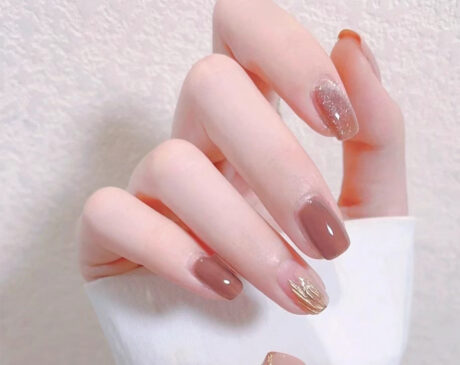Is Nail Polish Bad for Your Nails?
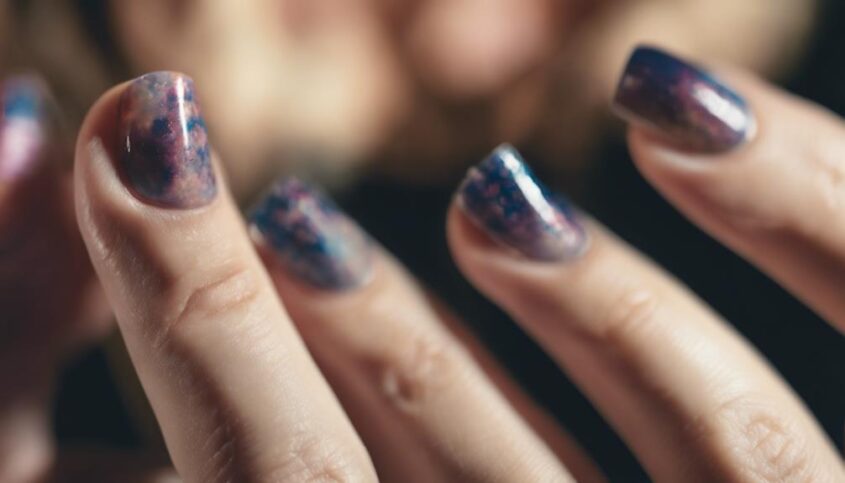
Nail polish can contain harmful chemicals like formaldehyde affecting nail health. These ingredients may cause brittle nails and discoloration. Opt for polishes without harmful chemicals or go for breathable formulas. Strengthen nails with keratin or biotin, and moisturize regularly to prevent damage. Give nails breaks from polish to maintain overall well-being. Safely remove polish by using acetone-free removers and moisturizing after. Consider alternatives like henna or DIY options for healthier nails. Remember, prioritizing strategies for healthy nails is essential for long-term nail health.
Key Takeaways
- Harmful chemicals in nail polish can weaken nails and cause damage.
- Opt for nail polishes without formaldehyde, toluene, or dibutyl phthalate.
- Prioritize nail health with strengthening ingredients like keratin or biotin.
- Use acetone-free polish removers to protect nail health during removal.
- Give nails breaks from polish to maintain overall nail well-being.
Potential Harmful Chemicals in Nail Polish
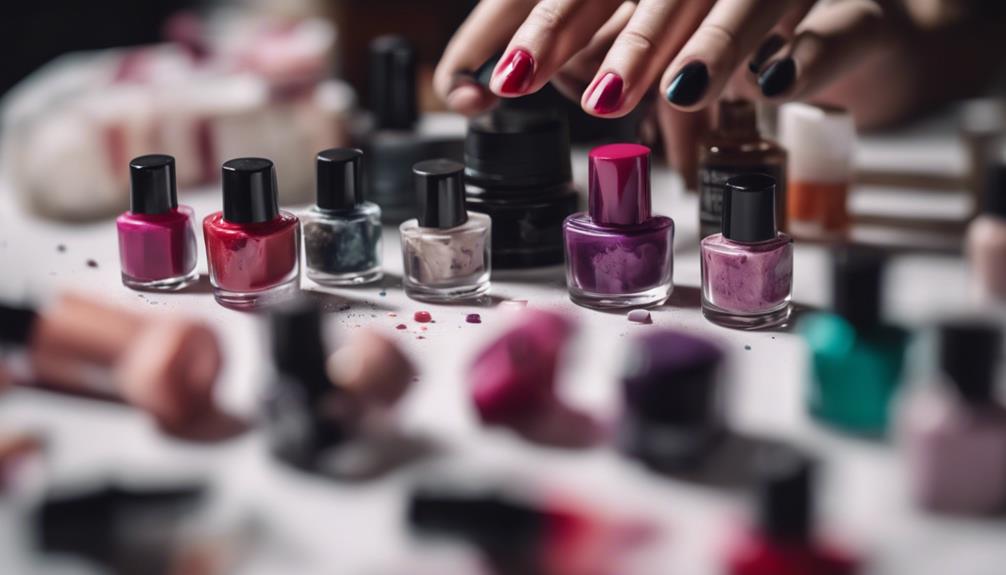
Nail polishes may contain various harmful chemicals that can potentially impact the health of your nails. While these products aim to beautify and enhance nail appearance, they may also pose risks due to chemical exposure. Some common ingredients found in nail polishes include formaldehyde, toluene, and dibutyl phthalate, which are known to have adverse effects on nail health.
One significant concern is the impact of these chemicals on nail strengthening. Formaldehyde, for instance, can lead to brittle nails, making them prone to breakage and damage. Toluene, another prevalent ingredient, may cause discoloration and weaken the nails over time. Furthermore, dibutyl phthalate, commonly used to add flexibility to nail polish, can have negative consequences on nail health, such as making them more susceptible to peeling.
As consumers become increasingly conscious of the potential risks associated with chemical exposure from nail products, there is a growing demand for safer alternatives that prioritize nail strengthening and overall nail health. Innovations in nail polish formulations are now focusing on creating products that are free from harmful chemicals while still providing long-lasting color and nail care benefits.
Impact of Nail Polish on Nail Health
The effects of nail polish on the health of nails can vary depending on individual factors and product formulations. When considering the impact of nail polish on nail health, it is essential to explore strategies that promote overall nail well-being.
- Nail strengthening: Opt for nail polishes that contain ingredients like keratin, biotin, or vitamin E, which can help strengthen nails over time. These formulations not only provide vibrant color but also work to enhance the natural strength of your nails, reducing the risk of brittleness and breakage.
- Hydration techniques: Prioritize nail hydration by incorporating cuticle oils or moisturizing treatments into your nail care routine. Hydrated nails are more flexible and less prone to damage, making them better equipped to withstand the effects of regular nail polish application. Look for products enriched with ingredients like jojoba oil or shea butter to nourish and moisturize both the nails and surrounding skin.
- Breathable formulas: Consider opting for nail polishes that are labeled as 'breathable' to allow air and moisture to pass through the polish layer. This can help prevent moisture buildup, reducing the risk of nail damage and promoting healthier nails in the long run.
Tips for Healthy Nails While Using Polish
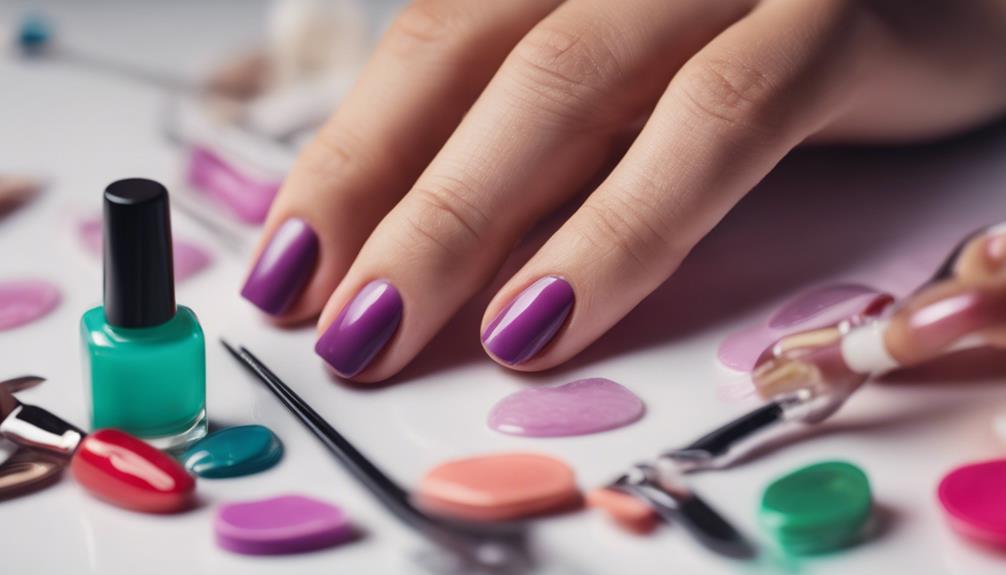
Maintaining optimal nail health while wearing nail polish requires diligent care and attention to specific practices that support nail strength and resilience. To ensure healthy nails while using polish, prioritize nail care by keeping them clean and well-trimmed.
Regularly moisturizing the nails and cuticles is essential for nail hydration and preventing brittleness. Opt for nail polishes that are formulated without harmful chemicals like formaldehyde, toluene, and dibutyl phthalate, as these can weaken the nails over time.
Additionally, consider using a base coat before applying nail polish to provide a protective barrier and prevent staining. When removing nail polish, opt for acetone-free removers to prevent excessive drying of the nails.
Remember to give your nails a break from polish occasionally to allow them to breathe and recover. By incorporating these nail care practices and ensuring proper nail hydration, you can enjoy wearing nail polish while maintaining healthy and strong nails.
How to Safely Remove Nail Polish
When looking to safely remove nail polish, it is essential to use gentle and effective methods that protect the overall health of your nails. To ensure proper nail care and safe removal, consider the following steps:
- Use Acetone-Free Polish Remover: Opt for acetone-free nail polish removers as they are less harsh on your nails. Acetone can strip the nails of natural oils, leaving them dry and brittle.
- Soak and Gently Rub: Soak a cotton ball in nail polish remover, place it on the nail for a few seconds to allow the polish to dissolve, then gently rub the polish off in one direction. Avoid harsh scrubbing that can damage the nail surface.
- Moisturize Afterwards: After removing the nail polish, make sure to moisturize your nails and cuticles. This step helps restore moisture and keeps your nails healthy and strong.
Alternatives to Traditional Nail Polish
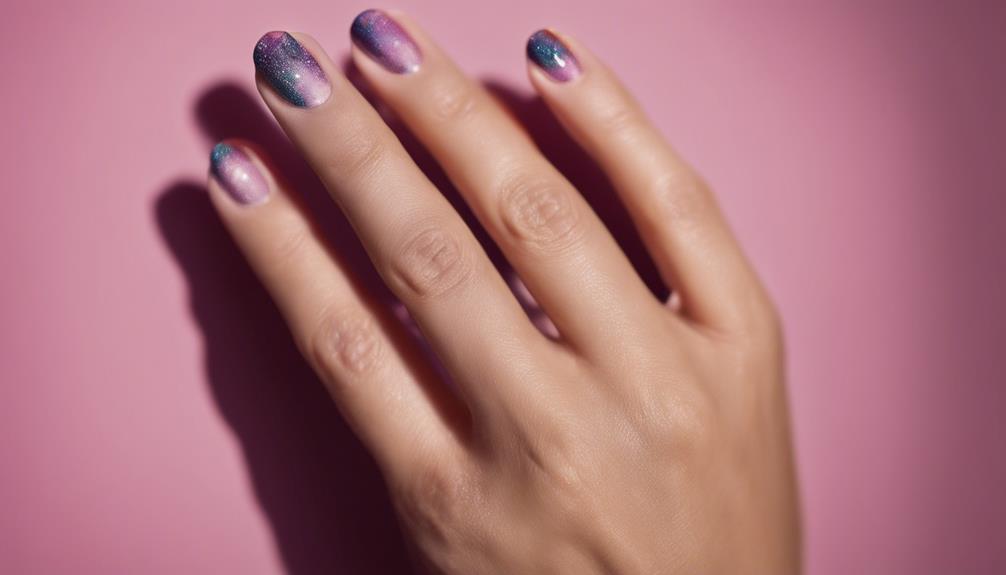
Exploring non-traditional options for nail coloring can provide a versatile and innovative approach to enhancing the appearance of your nails. Natural options offer a healthier alternative to traditional nail polishes. Ingredients like henna, beetroot, or even flowers can be used to create beautiful and unique nail colors. These natural options not only add color but also provide nourishment to your nails.
DIY alternatives are another exciting way to experiment with nail coloring. Creating your nail polish using ingredients like clear polish mixed with eyeshadow pigments or even cornstarch mixed with food coloring allows for customization according to your preferences. This hands-on approach can be a fun and creative way to express your style while avoiding the harsh chemicals present in some traditional nail polishes.
Frequently Asked Questions
Can Nail Polish Cause Nail Infections or Fungus?
Nail polish allergies can lead to nail infections, including fungal ones. It's important to be aware of the ingredients in nail products and practice good nail hygiene to prevent potential issues. Regularly changing polish and allowing nails to breathe can help maintain nail health.
Is It Safe to Use Nail Polish on Children's Nails?
In the realm of children's cosmetics, parental concerns about allergies are paramount. Ensuring safe nail polish products for kids involves diligent research and opting for hypoallergenic formulas. Remember, healthy nails are as precious as blooming flowers in a garden.
Can Wearing Nail Polish for Long Periods of Time Weaken the Nails?
Wearing nail polish for extended periods may weaken nails due to potential dehydration and chemical exposure. Proper nail care, hydration, and occasional breaks can maintain nail health. Choose nourishing polishes and strengthen nails with treatments for longevity.
Are Gel or Shellac Nail Polishes Safer Than Traditional Nail Polish?
Like a fortified castle, gel or shellac nail polishes boast a robust chemical composition, lending them superior strength and durability compared to traditional nail polish. Their advanced application techniques and long-lasting benefits set them apart.
Can Wearing Nail Polish Prevent the Nails From Breathing and Absorbing Nutrients?
Wearing nail polish may affect nail health by potentially limiting breathability. Concerns exist about the ability of nails to absorb nutrients and maintain optimal conditions when constantly covered. Innovation in nail polish formulations may address breathability concerns.
Conclusion
In conclusion, while some nail polishes may contain harmful chemicals that can weaken and damage nails, there are ways to minimize the impact on nail health. By choosing nail polishes that are free of toxins, practicing good nail care habits, and using safe removal methods, you can enjoy wearing nail polish without compromising the health of your nails.
Despite concerns about nail polish, taking proper precautions can help maintain strong and healthy nails.



